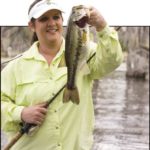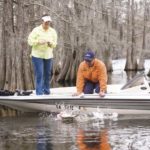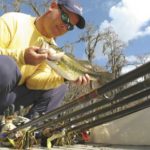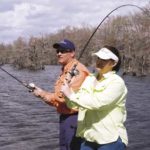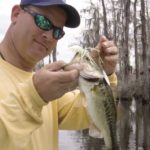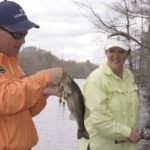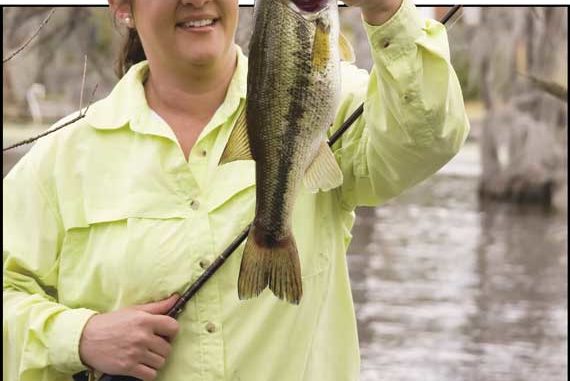
Conditions and fish are constantly feeding clues to observant bass anglers.
Kelli Batten lives in West Monroe, and she wants to learn how to catch bass well enough to be able to fish tournaments in the future. Her only problem is that the bass-fishing learning curve has become so steep that it’s almost impossible to climb it by herself. Wondering what would happen if she got an on-the-water crash course on basic bass fishing, West Monroe tournament angler Kenny Covington volunteered to be her instructor.
Having known Covington for several years, I can say he is one of the best anglers I’ve ever met when it comes to quickly discovering a pattern on the water. If Batten could quickly pick up on some of his insights, she would be well on her way to the weigh-in line.
Covington selected Bayou DeSiard in Monroe as our classroom, and we all met at the Louisiana Wildlife and Fisheries boat ramp at 7 a.m. Covington and Batten were already surveying the situation when I arrived ready to record their day on the water.
Our goal was to record with images and words what happened throughout the day. As I greeted both anglers, a confident Covington proclaimed that if Batten was able to learn anything from him this day, anybody who read the story could learn the same things.
As we idled away from the ramp, Covington couldn’t help but make keen observations.
“The first thing that struck me this morning is just how clear the water is,” he said. “This is unusual for this time of year, and I wasn’t expecting it. We’ve got upwards of 3 feet of visibility with 58-degree water. That means we’re going to have to sit down and change baits before we even begin fishing.”
Covington explained that he had tied on several brightly colored lures the night before — a firetiger spinnerbait and chartreuse crankbaits. All were bright and gaudy.
“I tied those on because I was expecting stained water,” he explained. “The problem is that those colors are overpowering in clear water, where bass feed more by sight than by any of their other senses. We’ve got to tie on more natural-looking colors like shad or crawfish patterns.”
Based on his initial observations, Covington felt our best bite would be based on sight, and because of the spring season, he expected that our bite would get better later in the morning.
“As the water warms in early spring, bass will get more active as the day goes on,” he explained. “The great thing we have going for us is that we have two anglers fishing, so I’m throwing a vertical lure while Kelli is throwing a horizontal lure. That should help us home in on the bite a lit quicker.”
• 7:23 — Covington spotted a small swirl on a dock about 50 feet in front of where we were fishing. It was the first sign of life, and Covington said it was an important one. He explained that subtle clues like a swirling fish could lead anglers in the right direction.
“The biggest problem anglers have, in my opinion, is that they fail to see the total picture,” he said. “You’ve got to totally see what’s going on around you, and spotting a shad flicking on the surface or a fish boiling the water are important clues to quickly patterning bass.”
• 7:30 — Covington got a bite on a jig that he pitched to a cypress tree, but he missed the fish. After Batten wondered if there were anything anglers could learn from missed fish, Covington explained that there was almost more to be learned from missing a fish than catching one.
“That bite wasn’t right on the tree,” he said. “My jig was out away from the tree when the fish bit. I popped it out of some grass, and that was it. However the fish picked up the jig and went toward the tree rather than away from it. That’s another clue that the fish was off the tree. Fish on a tree will bite and move off it rather than toward it.”
As he finished making his point, Covington clipped off his jig and tied on a black/blue Texas-rigged lizard. Seeing as how he just had a bite on the jig, I asked him why he was changing lures. He tossed the discarded jig to me. The pinchers of the crawfish trailer were missing.
“That fish just picked up the trailer,” he said. “When I get bites like that, it tells me I need to downsize to something smaller and more subtle.”
• 7:43 — After making a move to the other side of the bayou, Covington finally landed our first fish on the black/blue lizard. The bass, a small male, was on the inside of a couple of cypress trees that were out away from the rest.
“This small male fish tells me that the fish probably won’t be as shallow as we thought they might be,” Covington said. “The males are the first to pull up, and that fish has just made its move. The females could be on the outside of these same kinds of trees, or they could be out on deeper stumps.”
• 8:11 — Covington made a move to a different part of the bayou that was on the other side of a small bridge, and he continued throwing the lizard. Batten, on the other hand, was getting tired of throwing her orange crankbait, so she cut it off and had Covington tie on her favorite lure — a Rat-L-Trap.
A small fish followed my baby bass-colored Mann’s HardNorse jerkbait. The fish rose right up behind my lure, but it only half-heartedly tried to eat it, and turned away. Covington felt this might mean the fish were starting to get a little more active.
• 9:08 — Reeling in her Trap, Batten suddenly pulled back on a fish that bit right at the boat. The bass, a 1 1/2-pound male, didn’t seem like much at the time, but Covington would later call it the most important fish of the day. As for now, though, it created more problems than it solved.
“A lot of times that sudden change in motion right before you pull a lure up is what keys these kinds of strikes,” he said. “This bass probably followed it over the grass, and the fact that it was willing to chase a lure proves they are beginning to get more active. There’s no telling how far it followed the bait, though, so it might just be one of those ‘luck’ fish.”
• 9:50 — Covington nailed another 1 1/2-pound male bass on a 1/4-ounce double willow Mister Hootie spinnerbait. The bass bit in the same spot as Batten’s Trap fish, which made Covington grow more animated.
“This fish hit way out from the bank in 5 to 6 feet of water,” he said. “Looking back at our entire day, only one of our fish came directly on a cypress tree. And the one bite I missed on a tree was off of it more so than being on it. I think these fish are just starting to move up and wait on whatever signal Mother Nature gives them to move all the way to the bank.”
The few swirls and boils we had seen next to the bank were too skittish to bite, and Covington surmised that these were males that had probably just moved up the day before or even that morning. He decided we would continue working the roaming fish in the deeper water.
“We’re going to quit concentrating on trees, and fish around them rather than on them,” Covington announced while turning toward me. “We’ll continue throwing a spinnerbait and Trap, but you ought to switch to a jerkbait to see if they want it better than these.”
• 10:05 — A 3-pound female bass just destroyed Covington’s Mister Hootie spinnerbait. He had heavily modified the light-wire lure by trimming the skirt and downsizing the willow blades to try to get the lure to run slowly in deep water.
This fish made Covington feel like our pattern was as strong as it had been all morning. The bite was in the same kind of location as the previous two, and the fact that it was a larger female made Covington think that more fish would be moving up and eating spinnerbaits as the day went on.
“No we’re all going to tie on the same spinnerbait to try to maximize our pattern,” said Covington. “We’ll ride this bite until we get any tell-tale signs that it is changing.”
• 10:25 — The big bass may have been an anomaly as Covington’s next bass was an 8-inch male. However, this fish only solidified our pattern even more. Covington took the opportunity to explain more about his spinnerbait modifications.
“I love trying different things with these Mister Hootie spinnerbaits,” he said. “This is a light-wire version of the bait with a skirt that I took off a War Eagle spinnerbait. The clear skirt and smaller blades make this the perfect offering for clear-water bass that are in an active feeding mood. I can fish it slow and deep, or I can burn it closer to the surface as the fish get more active.”
• 11:40 — After moving to the other side of the bayou in an effort to get to cypress trees that were closer to the bank but that had a distinctive drop off, Covington landed his next bass.
“Even though it looks a little different over here,” Covington said while pointing out the duckweed that had blown against the bank. “This time of year, bass don’t want to have to move 50 or 60 yards across a large flat to get to shallow water. They like to get in areas that have shallow cover with deep water nearby so they can quickly retreat if necessary.”
The one difference that Covington pointed out was that this fish was closer to the cypress tree than the others had been. The fish was suspended right below the duckweed, which was just thin enough to pull a spinnerbait through.
• 11:55 — Covington caught another bass on the same pattern, yet he sat down and changed lures after releasing the fish. Confident that we had figured out how to consistently catch the smaller males, he was making an effort to try to entice larger fish.
“I’m going to a 1/2-ounce spinnerbait that I’m going to modify the same way but keep the larger blades,” he explained. “The females might not be up here, but maybe they are and they just want a lure with a larger profile.
Batten missed a fish while Covington was explaining his lure change. The bite was a swing and a miss, though, and she lamented that she still had a lot to learn.
“One of the things that has amazed me is just how good of a caster you have to be to catch these fish,” she said. “I would have never come over here to this duckweed in the first place because it looks like too much trouble to fish.
“Even without duckweed, though, I would have still been casting out away from the cover thinking that the fish would swim out to get it. Now it looks like you have to get the spinnerbait right to the base of the tree, and that means I’ve got to go home and practice my casting.”
• 12:10 — Covington’s larger spinnerbait produced a larger fish, which would prove to be our last. Although it wasn’t as big as the 3-pound fish, it was bigger than the typical males we had been catching. “A small female,” he called it. Our pattern was signed, sealed and delivered.
“Overall, I think we had a pretty good day,” Covington noted as we made our way back to the ramp. “The one thing I look back on that was key to our pattern was Kelli’s Trap fish. That was the most important fish of the day now that we can look back on it. We thought that fish followed her bait from shallow water, but it didn’t. It was exactly where the other fish were. That’s why you have to let every fish tell you something no matter if you think it’s a luck fish or not.”
The one thing about our day that surprised Covington was that we caught only the one Trap fish, which Batten continued to fish until Covington had her change to a spinnerbait.
“A Trap is a reaction lure,” he explained. “These fish were feeding on sight because they were hungry, not because they were aggravated. I think the spinnerbait did a better job of blending in and looking like bait at the same time.”
Batten might not enter a tournament next weekend, but she did come away from the day with some new ideas about catching bass.
“The most important thing I learned is to look at the water around you while you’re fishing,” she said. “I used to think all those little swirls and ripples at the bases of the trees were from the wind. Now I know that they’re fish.
“I also learned that there are a lot of variables that have to be taken into consideration to put together the best pattern available. Water temperature, water color, wind, time of year — it’s all important. I used to think bass anglers thought way more than they fished. Now I know that bass fishing is a thinking man’s — or woman’s — game.”
